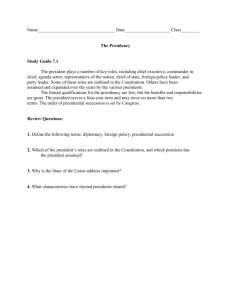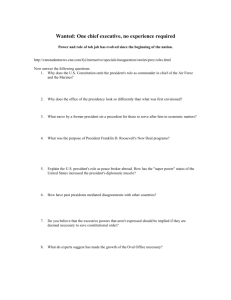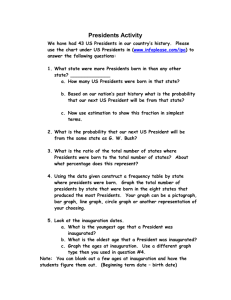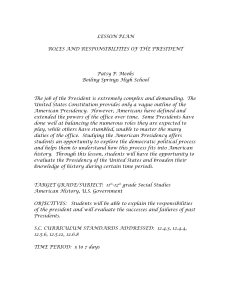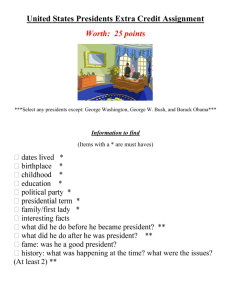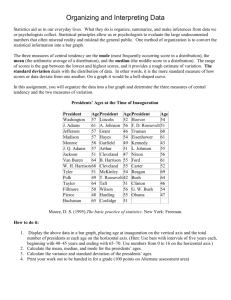Jodi Ellis/Laura Mros /Kathy Ann Black
advertisement
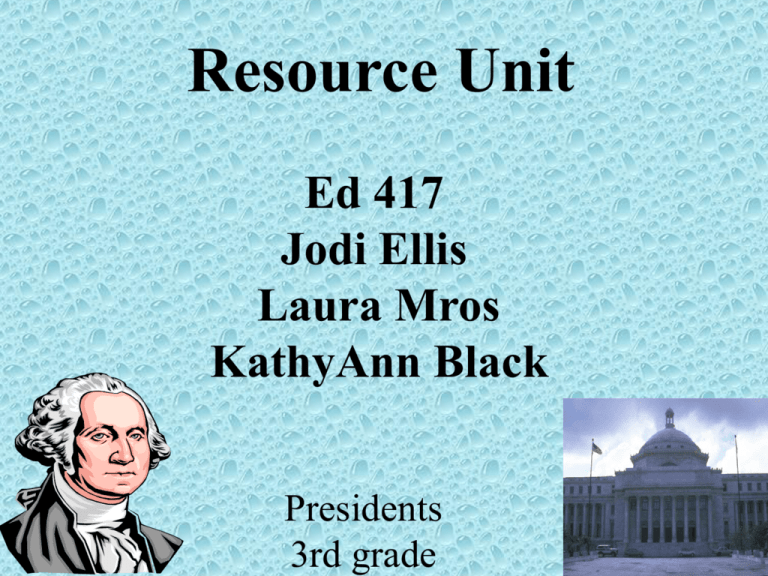
Resource Unit Ed 417 Jodi Ellis Laura Mros KathyAnn Black Presidents 3rd grade Table of Contents Section Presidents Page Number Introduction………………………………………..3 Content…………………………………………….4 Objectives………………………………………….9 Activities……………………………………….....10-16 Evaluation………………………………………...17-21 Instructional Resources…………………………..22 Teacher References………………………………22-23 Student References………………………………24-26 Media References………………………………..27-32 Introduction -3- Presidents It is important for students to be aware of what our United States Presidents have done in the past for our country as well as what they do for us today. It is also important that they realize that they can play a part in who our president is when they are old enough to vote or by encouraging those who are old enough to vote. In this resource unit the third grade students will realize the importance of the president. As well as the important achievements that different presidents have made for our country. This unit will take about seven days to go through. The students will gain an understanding of the Untied States Presidents through activities, videos, hands on experiences, and computer software. With all the knowledge they obtain from this unit they will be able to help convince their parents to vote if they do not already. Content -4- Presidents 1. President background On the first day the students will take a look at the president that they choose. They will look at his lifestyle before he became president. The students will do this through creating a time lime of events that happened during the life of the president before they became president. 2.Presidents Campaign On day two the students will take a look at what all goes into a campaign for presidency.The students will achieve this through a web diagram. Content -5- Presidents 3.Election The students will learn what an election is and all that goes into a election. They will do this through a mock election. 4.Events On the fourth day the students will learn about what took place during their presidents presidency. They will then add these Dates and events to their time line. They will also recreate on of these events in any form they feel suit the situation. 5.Achievements On the fifth day the students will find out some of the greatest achievements of their presidents. They will present these accomplishments through a poem. Content -6- Presidents 6.Political Party The students will take a look at what political party their president represents. They will gather information and then create a poster board displaying this information. 7.Importance of a President The students will look at the importance of having a president. The students will do by listing out what they think is important and then we will graph it as a class to see what most children feel is important. 8.Responsibilities The children will look at what the president is responsible for. They will do this through a web diagram. Content -7- Presidents 9. Evaluation On the final day of the lesson the children will be given a test over the information discussed during the unit. The test will be multiple choice and essay. The children will also have a choice if they would like to do an extra project for an additional fifteen points added to their test score. Content -8- Presidents Concepts Democracy Republican Independent Election Family Military Campaign Debate Sponsors Backers Impeachment Amendments Bill of Rights Civil Rights Act Ballot Candidates Popular vote Electoral vote Declaration of Independence Presidents Names President Cabinet White House First ladies Registration Objectives -9- Presidents Given the opportunities to correct materials, the students will be able to: 1.Give a definition of there presidents political party. 2.Name the three political parties. 3.List three that go into a campaign. 4.Name five thing about an election. 5.Name four events that took place during there presidents term. 6.List three of there presidents greatest achievements. 7. The students should be able to tell why a president is important. 8.List five of the presidents responsibilities. 9.Name at least five presidents of the united states. Activities -10- Presidents Day 1: Presidents Background Introduction:The teacher will introduce the unit and briefly talk about the activities to come over the next two weeks. The teacher then will talk about a few of our presidents to spark the interest of her students. She then will have the students come up a row at a time and pick a president they would like to research. It will be first come first serve so the row that is sitting best will get to choose first. Then the students will make a time line of events that happened to their president before he became president. Outcome: The students were introduce to the unit on presidents. They have a president that they will now continue to find information on throughout the unit. Today they learned about there presidents background. Development:.The students will develop library skills, math skills, creativity, English skills, and history skills. All these skills will be developed through the library research for materials to use and the time line they are going to create. Activities -11- Presidents Day 2: Presidents Campaign Introduction: The students will be introduced to the different parts of a campaign through a video and other material showing previous campaigns of the presidency. Outcome: The students will explore all the different aspects of a campaign further through web diagrams. Development: The teacher will ask the students things they would use in their campaign if they were running for presidency. They will later experience some of this during the mock election. Activities -16- Presidents Day 3: Running for President Introduction: The students will be introduced to a variety of president campaign slogans. The students will also watch videos that contain campaign slogans. Outcome: The students will then use this information and create their own slogan as if they were running for presidency. The students will make posters with their slogan on it, and they will use the poster during the mock election. Development: This will help the students see all that is involved when running for presidency. The students will also develop their language arts skills when coming up with a catchy slogan. Activities Day 4: Events -13- Presidents Introduction: The students will be introduced to some of the important events that took place during different presidency’s through a word search. This will help them to first become familiar with some of the words. Outcome: Students will use the words they found in the word search and determine which event took place during their president’s term. they then will recreate this event in however they see fit. They will be able to get a start on this in class and will finish at home. Example might be to recreate a war with figures and materials or recreate a document. Each recreation needs to have a description with it telling the importance and the effects the event had on the president and the country. All students will then present their recreations to the class. Development: This lesson will develop the students creativity skills as well as there historic knowledge. This will also show you how a student is learning through their recreation. Activities -14- Presidents Day 5: Achievements Introduction: The teacher will try and spark the students interest by telling them about all she has achieved in life. Then she will ask them what they have achieved. For instance if they know how to ride a bike and what they had to do to accomplish this achievement. Outcome: The students then will use the materials they have gathered on their president and write a poem that contains all their presidents achievements. Development: This will help students develop their research skills, language arts skills, and writing skills. Activities -15- Presidents Day 6: Political Party Introduction: The teacher will bring in pictures and objects that represent the symbols used for each political party, and discuss the importance of the symbols. Outcome: The student will develop knowledge about the different political parties that exist. They then will be able to create a poster with the information on the political party of their president. Development: The students will develop their creativity skills, political skills, and reason skills. Activities -16- Presidents Day 7: Election Introduction: The students will be introduced to the materials and aspects of election through pictures and objects the teacher will bring in. Outcome:The students will then use what they learned earlier and on previous days to create a mock election. Development: This will help develop the student’s collaboration Skills. They will also learn the importance of an election and how one vote can make a difference. Evaluation -17- Presidents Unit Test- Presidency Name:______________ Multiple Choice (1 point each) 1. Which president was the only president to be elected unanimously? a). George Washington b). George W. Bush c). John F. Kennedy d). Thomas Jefferson Evaluation -18- Presidents 2. This president authorized the Lewis and Clark expedition. a). Ulysses S. Grant b). Harry S. Truman d). Thomas Jefferson c). Bill Clinton 3. Who was the oldest man to be elected president? a). George Washington b). Ronald Reagan c). Thomas Jefferson d). John F. Kennedy Evaluation -19- Presidents 4. On January 23, 1863, this president issued the Emancipation Proclamation. a). Bill Clinton b). Ronald Reagan c). Abraham Lincoln d). George Washington 5. The two major political parties in the U.S. are the _______ and __________. a). Socialists, Democrats b). Libertarian, Socialists c). Democrats, Republicans d). Reform, Libertarian Evaluation -20- Presidents True/False (2 points each) 1. There has been a total of 38 president’s thus far. T F If false, correct the statement below to make the statement true. 2. The president can stay in office for a total of 10 terms. T F If false, correct the statement below to make the statement true. Evaluation -21- Presidents Short Essay (5 points each) Read each question carefully, then answer the questions on a separate sheet of paper. 1). If I were president I would… 2). Each of you had to research one president, I would like you to state at least five things you learned about your president. Resources(Teachers) -22- Presidents Beyond the Cherry Tree: Stories of the Presidents. Activity book. J. Weston Walch. 1996. Designed to help students identify with”the person behind the presidency.”each of the 41 biographies in this activity book begins with colorful anecdotes from the president’s youth, then discusses the major events of his adult life and term of office. Contains discussion questions, and group activities. Our Federal Government. 3 VHS videos, 3 guides. Rainbow, 1993. This video series provides a straightforward introduction to the three branches of government, emphasizing their cooperative roles in governing the nation. Contains review questions, activities, a reproducible quiz, and script. The American Presidents. Activity book. Monday Morning. 2000. This learn-by-doing book ties 130 simple craft projects to intriguing facts about our chief executives. Contains president and first-lady cards, the White House, flags and symbols, and a 50-state map. Resources(Teachers) -23- Presidents We the People. Paperback book. Teacher’s guide. Center of Civic Education. This teacher-written book embraces the Constitution, the Bill of Rights, and what it means to be a responsible citizen. Contains copies of the Declaration of Independence and the Constitution, biographies of framers, and a glossary. Electing a President: The Process. VHS videocassette. Rainbow, 1993. This traces the evolution of presidential elections from Washington to Clinton. Topics include president eligibility requirements, the electoral college, primaries, conventions, and debates. Contains a teacher guide. Resources(Students) -24- Presidents You are the President. Hardback book. Nathan Aaseng. The Oliver Press. 1994 This book contains a series of challenging questions designed to make students weight options, plot strategies, and make risky decisions about all aspects of a president’s life. The students’ decisions are them compared to the decisions by the great presidents. Hail to the Candidate. Paperback book. Keith Melder. Smithsonian Press, 1992 A 212-page reference book celebrating 200 years of presidential campaigns. Fully illustrated volume shows the devices used to capture voter attention from Washington to Bush. Captures the essence of the election and campaigning. Electing a President. 30 poster worksheets. Teaching & Learning Company. 1996 Hands-on projects that teach how elections work. Students apply research, thinking, and artistic skills to illustrate the election process. Presidents of the United States. 82 cards, guide. Media Materials. 1996 Provides a wealth of activities and games for learning centers, individual or cooperative play, or class openers. 41 presidential biography cards and 41 picture cards to play games. Resources(Students) -25- Presidents Presidential Puzzlers. Activity Book. Good Year. 1999 Presidential tidbits form the basis for word-searches, crossword puzzles and other games. Students might need to do a little research at the library to find some of the answers out. Presidential Elections: A complete Resource with Historical Information. Activity book. 1999 Priming future voters for elections in 2000 and beyond, the lessons in this book help them learn about political parties and conventions, the mechanics of running a campaign, and the election process itself. Contains directions and worksheets for staging mock presidential election in the classroom. Beginnings -Civilization and Government:Tell Me Why. VHS Videocassette. Penguin Productions. Students are shown the origins of American institutions and customs in this entertainment program based on the acclaimed Tell Me Why Books by Arkady Leokum. Resources(Students) -26-Presidents Encyclopedia of the Presidents and Their Times. Hardback book. David Rubel. 1997 This easy-to-use, one-volume reference surveys American history by examining the terms of the presidents from Washington to Clinton. Electing the President: Inside the Government. Hardback book. Barbara S. Feinberg. Twenty-First Century Books, 1995. This book contains an overview of all the steps involved in electing a president, including primary process, national conventions, and campaigns. Contains illustrative historical examples. Presidents of the United States Fact Cards. Fact cards. Toucan Valley. Second edition. 2001 An ideal starting place for student projects and reports, these reproducible 8 1/2 x 11 double-sided cards are conveniently housed in a three-ring binder. Each illustrated card displays basic data for each president from George Washington to George W. Bush. Resources(Media) -27-Presidents Hail to the Chief: Presidential Elections: VHS Videocassette. Sunburst. 2000 In concise narration accompanied by graphics and archival footage, this basic introduction looks at the history and present-day procedures involved in electing a U.S. President. The American President: VHS Videocassette. Boxed set. WNET/Kunhardt. 2000 These videos are compelling 12-20-minute profiles of America’s first 41 presidents and they are organized thematically. The Presidency: VHS Videocassette. Rainbow. 1993 The responsibilities of the chief executive are outlined, as are the many offices and departments that help the president discharge those duties. The 30-Second President. VHS Videocassette. CEL/BDM. 1984 This is a documentary of political advertisements on television. Specific coverage of presidential elections. Top ad execs analyze the effects this country’s most memorable commercials had on that “one-day sale” held in America on a Tuesday in November. Resources(Media) -28-Presidents Electing a President: VHS Videocassette. Rainbow. Tracing the evolution of presidential elections from Washington to Clinton, this video introduces students to eligibility for office, the electoral college, primaries, conventions, and debates. State Government: Hardback book. Ernestine Giesecke. Heinemann Library. 2000 Concise and easy to understand, this volume defines the purpose of state government, and introduces the functions of the three branches of government. Readers also learn about who can run for office and how they are elected. Presidents: Hardback book. Eyewitness books. James Barber. Dorling Kindersley. 2000. A richly pictorial, chronological catalog of America’s presidents amplifies its terse summaries of their terms in office with full-color captioned portraits, images of campaign paraphernalia, political cartoons, and archival paintings and photographs. Resources(Media) -28-Presidents All About Elections: CD-ROM Software. Thomas S. Klise Company 1999 Full-color cartoon slides, clear audio, and informative text explain the election process. A factual introduction explains the basics: who may vote and the election process. Difficult words are highlighted and linked to definitions. The American Presidency: CD-ROM Software. Grolier. 1999 Biographies of the presidents drawn from three different encyclopedias make this CD-ROM a perfect starting place for research and report writing. Students can also use hot links to jump directly from the CD to the World Wide Web and access the home pages of presidential libraries and birthplaces. Campaigns, Candidates, and the Presidency: CD-ROM Software. Compton’s New Media. 1995 This software has an in-depth analysis of the issues, events, and outcomes of every presidential campaign from Washington to Clinton. CD contains narrated montages of the elections and terms of office. Contains a presidential trivia game that lets students make their own run for the high office. Resources(Media) -29-Presidents Elections: Activity book. Carson-Dellosa. 1998 This book covers election basics in 17 articles with multi-level worksheets. The activities include running for election, who votes, opinion polls, campaign financing, and what it takes to win. Candidates, Campaigns, and Elections: Activity book Scholastic. 2000 This three-part book features high-interest games and activities geared to different ability levels. “Election Basics” surveys the electoral process, voter registration, and voting. Contains a fold-out poster, “Electing Our President.” U.S. Presidents Puzzles: Puzzle book. Carson-Dellosa. 2000 The 16 crosswords, five word searches, and one grand scramble with every president’s first and last name balance fun with learning. Fact sheets with pictures of each chief executive give the information needed to solve the puzzles. Resources(Media) -30-Presidents Our Nation’s Capital: Activities and Projects for Learning About Washington, D.C. Activity book. Scholastic. 1996 Readings, activities, and a game introduce the landmarks and history of America’s capital. Presents each landmark-the White House, Capitol, Supreme Court, Smithsonian, and the Lincoln, Washington, Jefferson, and Vietnam Memorials. The Voting Machine: HyperCard Presentation, Career Publishing This presentation transfers a computer into an official balloting machine for school elections. Menu driven and very easy to operate, the program allows the user to prepare ballots, collect votes, and tally results. Contains an extensive guide, I voted today labels, and three wall charts. Branches of Government: Posters. Knowledge Unlimited. 1996. Displayed together, these colorful posters help students compare the executive, legislative, and judicial branches of government and understand checks and balances. Also shows the qualifications, terms of office, and basic duties of the president. Resources(Media) -31-Presidents Executive Branch Posters: Posters. Waterwheel. 2001 This is a black-and-white poster of portraits of each of the presidents in chronological order against a colorful background. United States Presidents: Posters. White Mountain. 2001 Captioned portraits of every president surround a map of the U.S. filled with facts about our chief executives, including birthplaces, monument sites, fascinating tidbits, and accomplishments while in office. Election 2000: Issues and Personalities of Campaign 2000 in Caricature and Cartoon. Transparencies. Highsmith. 2000 Using 12 cartoons, the lessons in this booklet deal exclusively with the 2000 presidential election. Transparencies of the 12 cartoons focus class discussions and debates on the parties, the candidates, and the issues most on the minds of the voters. Resources(Media) -32-Presidents American Government. Laserdisc. CEL. 1994 This covers two main areas. Parties and Campaigns and The Presidency. The disc is organized into 40 segments of interactive full-motion video. Content includes clips from a televised election night and in-depth analysis of this election. Contents include a 35-page guide containing thought questions, classroom exercises, reading lists, and biographical data.

